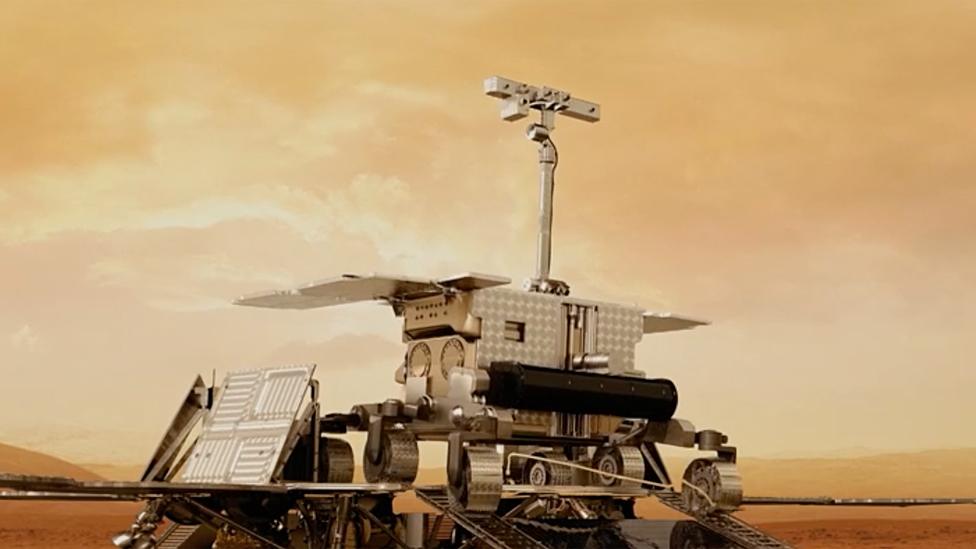Europe's Mars rover takes shape
- Published
Airbus engineer Abbie Hutty gives a tour of the ExoMars rover test model
So, here it is. Europe's Mars rover. Or rather, a copy of it.
This is what they call the Structural Thermal Model, or STM. It is one of three rovers that will be built as part of the European Space Agency's ExoMars 2020 mission to search for life on the Red Planet. And, no, we're not sending all three to the Red Planet.
The STM is used to prove the design. It will go through a tough testing regime to check the rover that does launch to Mars - the "flight model" - will be able to cope with whatever is thrown at it.
What's the third robot for? It stays on Earth and is used to troubleshoot any problems. If mission control needs to re-write a piece of software to overcome some glitch on the flight rover, the patch will be trialled first on the "engineering model" before being sent up to the Red Planet.
It's getting real, then. After all the delays and arguments, the ExoMars hardware is at last taking shape.
The STM, which has been assembled at the Airbus factory in Stevenage in the UK, is about to be boxed up and sent to a facility in Toulouse for environmental testing.
"We're going to 'shake and bake' it to demonstrate that the rover can survive all of the vibrations and acoustic loading during the rocket launch, all of the shocks of deployment, and then all of the thermal stresses it will experience - all the highs and lows - both when it's in deep space and on the surface," explained engineer Abbie Hutty.
"This is where we qualify our design, proving that it meets the requirements."

Artwork: The ExoMars rover will launch in 2020 and land in 2021
Esa member states will meet on 8 May for the Critical Design Review. This will consider every aspect of the venture and is really the last chance to change some aspect of the mission. There may be some tinkering at the edges, but the broad scope will not alter.
There have been recent difficulties related to the "Analytical Drawer", which will hold ExoMars' life-seeking instruments. A leak was found in the test model for this box and a membrane also failed. "But, OK, this is why you do testing," said ExoMars project scientist Jorge Vago.
"Overall, I think we're on a good track to complete everything we need to do. We have margin. It could be better, but we're not working double shifts and on weekends, which is what you see on most projects towards the end."
ExoMars is a joint venture with the Russians. They're building the descent module - the mechanism that gets the rover down to the surface once it enters the planet's atmosphere.
A structural model of this system is also in production, and when the rover STM completes its Toulouse exams, the two will have a fit check in Moscow and undergo another round of testing as a combined unit.
Watch a timelapse movie recording the assembly of the ExoMars rover test model
A couple of developments in the rover's capabilities are worth reporting. It's now been confirmed the robot will be able to wheel-walk.
This is a driving mode that sees the vehicle lift up its wheels and take steps - as opposed to just rolling forward. It would allow ExoMars to tip-toe out of a sand trap, if it gets caught in one. Nasa's Spirit rover was snared in this way and the mission lost as a consequence.
Wheel-walking was in the initial spec for ExoMars and then withdrawn for cost reasons. I'm pleased to report that member states have found the money to put it back on the rover.

Artwork: Russia will provide the mechanism that puts the rover on the surface of Mars
The other key capability that needs a similar response is autonomous navigation. This self-driving system would permit the robot to plot its own path across the surface of Mars, independently avoiding hazards such as large rocks and trenches.
Without it, controllers back on Earth have to direct every move, and that's a very slow process.
"Clearly we need it, otherwise we will pay a high price in terms of the science you can do," Dr Vago said.
"To give you an example - if we need to move 500m, with autonomous navigation we can do that in five days. Without it, the drive might take 15 days."
Whether the rover gets this smart upgrade is probably going to depend on the UK and French space agencies.
They're the parties most interested in the technology and will have to fund it.
Fortunately, autonomous navigation is a software complement, so even though hardware choices have to be locked down now there is still some extra time to resolve this particular issue.
If you're wondering where ExoMars will be sent, the decision will be made in November. Scientists will meet at Leicester University to choose between two equatorial locations, known as Oxia Planum and Mawrth Vallis.
They're both areas rich in clay minerals - the kinds of sediments that must have formed during prolonged rock interactions with water.
Jonathan.Amos-INTERNET@bbc.co.uk, external and follow me on Twitter: @BBCAmos, external